Posts Tagged Gilgamesh Epic
Creation of the Sun System and the Zodiac
Posted by Kim Graae Munch in Astrology, Esoterics, Indian esoteric on January 25, 2012
The World Egg is the most universal symbol we have, and the Zodiac is the most developed form of it, but we find it everywhere in all cultures, we just don’t recognize it as representing the world egg.
See also this album: The World Egg and the Zodiac
We can find the history of the zodiac in the four heavenly beasts, Eagle, Lion, Ox and Man; they were the first members of the Zodiac, first later came the Cardinal signs, and later again the mutable, they came when man began developing these qualities, just as the outher planets first became visible when they became influential.
Amma created the egg, what became our sun system, not the whole universe. Within his egg, Amma began spinning around, forming the po seed. The po is the smallest invisible seed at the center.

Amma then placed seven ‘words’ [Planets] in the po, which began to vibrate strongly within the seed. The spiraling vibrations caused four clavicles to grow forth from the po.

These were the four heavenly beasts, the fixed star signs. These four powers were the main factors in developing the sentient soul, Eros of Plato, or Tamas of Hinduism.
These four Androgyne beings split into four male and four female, so we now had the cardinal and fixed star signs. The cardinal powers were necessary for developing the intellectual soul, or Logos of Plato, or Rajas of Hinduism.
The Dogon call these beings the Nommo Anagonno, ‘The Word (Nommo) that Became Fish-Man’ (Anagonno). The male and females got a son, and the mutable star signs was created. The mutable signs were necessary for developing the conscious soul, Thumos of Plato, or Sattva of Hinduism.
The Nommo entered the world through the place on the sky where Sirius is placed. They were the teachers of mankind, the Angels. They are also associated with the moon.
This Zodiac are fields going from the circumference around the sun system into the system, not just radiation, and not from the large universe, this is called the Tropical Zodiac.
 Tropical Zodiac
Tropical Zodiac
The Egg, the Zodiac are spiraling through the universe so it’s changing position in relation to the stars, but the fields are constant in relation to the Sun system, to the vernal equinox:
 Sun-system passing through the universe
Sun-system passing through the universe
It can also be seen in this fashion:
 Sun system through the universe
Sun system through the universe
Man is created in the likeness of God, here in embryonic form, folding itself out from the circular form:
 Man Embryonic form
Man Embryonic form
We are not a copy of the whole universe, we are a copy of our own sun system, not including far sun systems.

Auric form of man:
 The Auric Egg
The Auric Egg
Lucifer gives visions. One has to break through them, otherwise one doesn’t break through the shell that’s around every man and covers the real spiritual world. Visions and voices are around us like the shell around a chick. One might see an angel in a vision and when one presses through the vision the angel will change into a snake, Lucifer’s symbol, for at the Temptation he appeared as a snake. Or one might see the colour blue in one’s meditation — if one breaks through it the blue can become red, and then it turns out that we saw our own passions. As a result of his temptation by Lucifer man doesn’t have everything that the Gods have; he received knowledge, but not life. Thereby everything that we know and perceive is permeated by Lucifer and Ahriman. … An ordinary man is like the chick that would consider its shell to be the real world. If the chick could see, it would see the egg’s contents as if it were the whole world. Likewise we see our eggshell or aura spread out around us as the blue dome of the heavens. If we break through our shell the sun and moon become darkened, the stars fall down onto the earth and the spiritual world spreads out in its place.
A man lives in his eggshell — his aura. The Elohim gave us our aura, and through the fall into sin it has become like a shell around us, and we’re in it like a chick in an egg. The stars in the heavens are our boundary and we must break through it with our soul force, just as a chick must break out of its shell through its own power. Then we get into a new world, just as a chick has a new world before it when it has crept out of the egg. And since men all have the same eggshell around them an astronomy could arise that lets the heavenly bodies move along the celestial dome. The egg shell is the Ex Deo nascimur. To break through it and to bring something with us into the spiritual world we must bring what penetrates the shell from the outer spiritual world and that’s common to all; and that’s the Christ. That’s why we say: In Christo morimur and hope that when we’ve broken through the shell we will be awakened again: Per Spiritum Sanctum reviviscimus. Esoteric Lessons Part III
Formed as the world egg:
 Mithras
Mithras
Wael Al-Mahdi have made an analysis of the fight between Mittras and the bull, which have it’s like in the Gilgamesh epic. Today we have our mental focus in the Ego, the Intellectual soul or left brain hemisphere, but then our mental focus was in what we today call our subconsciousness, the Sentient soul or Limbic brain. This fight describes the change of focus from the sentient soul to our current ego, but it’s an ongoing fight between our ego and the subconsciousness, or rather it’s a fight between our superconsciousness and subconscioussness and the battleground is the ego. Wael Al-Mahdi writes that Mithras is the devine ego, but I see him as the ego, the lower I, where I see his father, the mighty Sol Invictus, as the higher I.
Let us now take a look at the symbolism of the Mithraic mysteries and try to make some sense of them. Mithras himself, in the manner of all epoch-making developments of the unconscious, appears suddenly and unexpectedly, from a rock. Here Mithras takes on the role of the divine ego – the ego of the average man transfigured and lifted up by energy from the unconscious harnessed through myth and ritual. In this Mithras is strong, solid, rocklike. The divine ego and the everyday ego (the one that worries about food, shelter, money etc) are not identical; the divine ego, despite its disctinctness but in keeping with unconscious manifestations, is foreign, in this instance, of exotic Persian origin. To symbolize freedom from the unconscious as enemy, and also the actual emancipation of freedman Mithraists, Mithras dons a Phrygian cap, the so-called liberty cap. With the rise of Mithras, miracles are performed, as he strikes a solid rock with the thunder of consciousness and live-giving water spouts from the rock. Here the dead and inanimate can produce life, just as a psychological impasse can give rise to a new lease on life; the Qur’an states of God, “He brings the living out of the dead, and the dead of the living.”
The central and most striking image of Mithraism is the tauroctony – the slaying of the bull. This supreme act of defiance, even hybris, is depicted on subterranean murals in Mithraea from Britain to Rome to Syria. The bull in his power and animal intransigence is the unconscious as enemy. He is the personification, or rather theriomorphization, of all the alien powers that ailed the forward looking man of action. He is the heaviness of the heart at dawn, he is the tightness of the chest before a dangerous act. He gives rise to the autonomous moods of self-doubt and self-loathing. He is boredom, lack of meaning, existential ennui. He represents every social disappointment, lack of control, failure to follow custom, and most dangerously, lack of adaptation. The evil father, father as a depressant, is in the bull – as is the evil friend, the devil, who both attacks the ego and forces to do evil. Every worthless feeling of the ego is projected onto him – and he is indeed a fitting target of projection. In short, he is the great No to life. He is the enemy within that must be vanquished if the conscious ego is to grow.
In contrast to conciliation myths, in which the ego tries to make peace with the unconscious, here the ego strikes with its readiest weapon – its will. After a long chase and a difficult haul to the womb-cave where a transformation can occur, Mithras’ right hand performs the unspeakable act of stabbing the bull’s neck. The cave serves a dual purpose are both regenerative womb and the unconscious cosmos which parallels the real cosmos. But there is respect in Mithras – out of respect, he pulls the animal back by the nostrils, never by the horn. Mithras’ face is serene, almost sublime – divinely devoid of emotion, Zen in his imperturbability – looking up towards his father, the mighty Sol Invictus, the Invincible Sun, as if saying, “Behold my most brazen act, father. Soon we are to become equals” Mithras is steadfast, unflinching – he takes full responsibility for his act, he never hesitates or backs down. As a result of Mithras’ challenging of the evil-animal father archetype, Father Sun emerges in a more human guise but with his divinity still intact.
In some reliefs the sacred bull bleeds wheat or grapes, symbolizing the paradox of the ability of the unconscious, even at is most evil, to heal after it harms. The killing of the bull is not a real-world death but an unconscious event that breathes life into a new psychological energy and outlook. But Mithras, this self-overcoming hero, is not alone in his daring act. Like all good heroes he has his sidekicks, the torchbearers, Cautes with his torch pointing up and Cautopates with his torch pointing down. They are his awareness of opposites, his ability to make distinctions, to discern opposites, and in their astral aspect symbolize his heavenly outlook. There is his dog too, lapping up the bull’s blood – his discipline, self-control, honed intellect, and the vital ability of self-obedience. On the scene is a serpent of wisdom and shrewdness, also drinking the life giving blood, for no quantum is wasted here. A sneaky scorpion sucks the ‘vim’ out of the bull’s genitals, literally ‘breaking his balls’ – energy that can be better utilized by the conscious hero Mithras. Mithraism and the Unconscious as Enemy
More on the Tropical vs. Sidereal Zodiac(Bruce Scofield):
We all know that this astrological system (Vedic) uses one or another version of the sidereal zodiac, the slight differences between them being measured by what is called the ayanamsha, the gap between the tropical and sidereal zodiac.
The twelve sidereal-based zodiacal signs (rasis) used in this system are not particularly important overall, and they serve more as a background reference plane for planets than as a matrix for personality distinctions.
The houses are important, however, but house boundaries between planets will remain roughly constant in a timed birth chart no matter which zodiac is employed. After reading a number of texts on the subject it became apparent to me that Hindu astrology was a tradition that was not concerned with extracting psychological insights from birth charts, it was more event-oriented.
and
In my opinion, Rudhyar remains the most important astrologer of the 20th century. He had something intelligent to say on just about every issue in astrology, including the sidereal-tropical problem.
Rudhyar wrote that the sidereal zodiac, the zodiac of constellations, was a product of the myth-making faculty of the human psyche. These constellations, groupings of stars, are a remnant of an earlier age that saw the rise of agriculture, but they are not relevant to modern life.
He felt it was unfortunate that both zodiacs use the same names for their 12-fold division of the yearly circle, and he regarded the tropical zodiac as being the proper framework on which to assess the evolution of mankind.
 Tropical Zodiac
Tropical Zodiac
Or
 The Sun orbiting the Earth equator defining signs of the Zodiac.
The Sun orbiting the Earth equator defining signs of the Zodiac.
Distance to the Stars of the Signs
The star signs are purely symbolic, giving name to the star signs because they were at the particular part of the zodiac when the twelve 30° degrees parts of the ecliptic was named.
The stars in the signs are nowhere near each other, they may even not exist anymore, they are placed long from each other in the far past of the universe.
History of Tropical Zodiac
The classical zodiac was introduced in the neo-Babylonian period (ca. 7th to 6th century BC). At the time, the precession of the equinoxes had not been discovered. Classical Hellenistic astrology consequently developed without consideration of the effects of precession.
The discovery of the precession of the equinoxes is attributed to Hipparchus, a Greek astronomer active in the later Hellenistic period (ca. 130 BCE).
Ptolemy, writing some 250 years after Hipparchus, was thus aware of the effects of precession. He opted for a definition of the zodiac based on the point of vernal equinox, i.e. the tropical system.
While Ptolemy noted that Ophiuchus is in contact with the ecliptic, he was aware that the twelve signs were just conventional names for 30 degrees segments (especially since the Aries sign had ceased to be in contact with the Aries constellation already in his time). Wikipedia
He connected the thirty degree segments to the time of year, with the traditional names given.
 Ophiuchus or Scorpio by Christian Borup
Ophiuchus or Scorpio by Christian Borup
The Zodiac with the old rulers:
It is as a round table with twelve seats, with the King and Queen sitting together as Leo and Cancer for Sun and Moon, with the ten other seats taken by the knights. From The Sons of Jacob and the Zodiac.
Comments
Po Tolo (Sirius B) the oldest of stars, it’s name means ‘deep beginning’. The Dogon consider Po Tolo the reservoir and source of all things in this realm, and the germ of creation for our Solar System. It ejected it’s essence out into creation, and the particles of it’s essence was ‘infinitely small’.
References
Reconciliation of the Tropical and Sidereal Zodiacs. Part III.
Who are Gilgamesh and Enkidu
Posted by Kim Graae Munch in Esoterics, Rosicrucianism on June 4, 2010
Who are Gilgamesh and Enkidu
There are at least two levels or stories in this epos. There are the story about two human beings and their endeavors, and there is the story about mankind, where Enkidu symbolizes the sentient soul and Gilgamesh the Mind soul, the Ego.
On the personal plane we learn through Enkidu the descent into the physical plane and through Gilgamesh the ascent up from the physical plane.
I will here try to find the deeper aspects of these beings in the esoteric history of man, looking at them as persons and as symbols. The first part will mainly build on Rudolf Steiner’s “Occult History” lectures 1 and 2, concentrating on the persons of Gilgamesh and Enkidu, or Eabani as Steiner calls him. In the second part I will look at the events on the spiritual plane to show their symbolic nature.
From Occult History by Rudolf Steiner
In Occult History Rudolf Steiner tells:
These beings are the highest developed persons within the human wave, and already on the old Moon were they selected for their part in the development of Earth. We know them as the twelve Bodhisattvas, the seven Sages, and as Christian Saints.
In the start of the second lecture RS elaborates on this theme:
This is the definition of the Bodhisattvas and their helpers, who are guiding the human history through the recurring crises caused by the powers of resistance.
The Gilgamesh epic is a remarkable myth, describing the esoteric path as it is until our time and written as it was written for us.
The myth describes the development until the initiation, which first became possible later.
Who are Gilgamesh?
As the previous quote says, Gilgamesh is a being with enormous potential.
Now Gilgamish was a personality who had many incarnations behind him and may therefore be called an “old” soul within the evolution of humanity…The souls who came down early have therefore more incarnations behind them in earth-evolution than those who came down later; hence we can call these latter, in contrast to the former, “younger” souls — souls who have taken less into themselves…
In the case of Gilgamish, the Being who was to reveal himself through him, and who could do so only by leading him presently to a kind of initiation, kept a guiding hand upon him from the outset and set him at the place where he came to recognise his own position in the history of the world…
The whole nature of an old soul will enable it early in life to grasp not only the essential element, the essential factor, in the existing culture, but also that which strikes into it as a new impulse, opening up a wide vista into the future. [2]
Gilgamesh incarnated back in Lemuria, maybe as the first of the development wave of man. Through his many incarnation he had reached a stage about where man were at the time of the Maid of Orleans. 2 This is one of the reasons why RS uses the word personality about him, he has developed the Ego as no other person have at this time in history, he have lost all connections to the spiritual world, and is as Ahrimanic as a man can be, as the son of Adam, Cain. His task is to form the development of the Earth, he is the archetypal Hero.
It could be understood as nephesch (sentient soul) and ruach (mind soul) are full developed, but that n’schamah (consciousness soul) is not, two out of three.
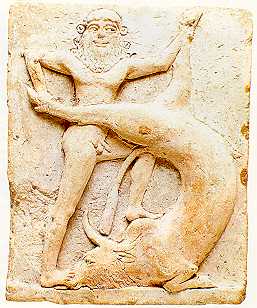 Gilgamesh – The Archetypal Hero
Gilgamesh – The Archetypal Hero
Who are Enkidu?
Enkidu (Eabani) is a diametrical different being; Enkidu is a being with few incarnation, ego-less and without karma, he lives in innocence with the animals. Through Enkidu’s encounter with a woman he acquires karma and becomes part of humanity, becomes part of civilization.
…
Eabani is depicted as being clothed in skins of animals. This is an indication of his wild nature; but because of this very wildness he is still endowed with ancient clairvoyance an the one hand, and an the other hand he is a young soul who has lived through far, far fewer incarnations than other souls who have reached a high level of development. Thus Gilgamish represents a being who was ready for initiation but was not able to attain it, for the journey to the West is the journey to an initiation that was not carried through to the end. [1]
In contrast to Gilgamesh, Enkidu is a young soul, without Ego, but with highly developed spiritual faculties, which Gilgamesh have lost. It can be said that Enkidu is the most Luciferic being born on Earth.
Enkidu’s task is to give Earth the Heavenly Wisdom to help man form the future. He is the archetypal Seer or Priest, as the son of Adam, Seth, the last born.
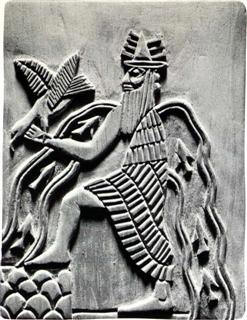 Enkidu letting wisdom stream out over the world
Enkidu letting wisdom stream out over the world
Here we see Enkidu placed as a helper for Gilgamesh, where the Luciferic Enkidu should bring equilibrium with the Ahrimanian Gilgamesh, helping him to purify humanity.
Enkidu represent wisdom.
Gilgamesh and Enkidu
These two are born again and again through history, as the bringer of Wisdom and of Form, as Teacher and Hero, as Aristotle and Alexander, or Aquinas and Christian Rosenkreutz.
In the bible we see them showing the shift from the old clairvoyance to the knew, for example as Esau (red and hairy hunter) and Jacob, or as Solomon and Hiram Abiff [Temple Legend]
The spiritual strength of these two are shown through
These great ‘personalities’ incarnates each hundred years, as Steiner describes in connection with Christian Rosenkreutz and Master Jesus, and it’s naive to believe that these big human beings only have been incarnated the few times as some seems to believe. If you read the Occult History and look for the word ‘personality’ it will point to further incarnations of these persons.
From the Gilgamesh Epic
Steiner tells that this epic describes physical reflections of the spiritual, and that should be considered in the mentioning of Ahriman and Lucifer in the following. I try here to show the two companions relation to the Ahrimanian and Luciferic, to explain their physical roles described in the previous chapter.
Gilgamesh is described as a man with all knowledge, showing him as a highly developed human being, with full control of the physical world, a doer:
The text on the stone states that he is two third god and one third human, king and super human, but he oppresses his people harshly, uses his power egoistically for his own satisfaction.
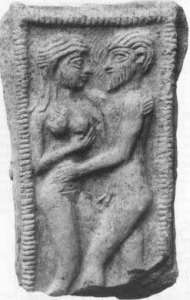 The people call out to the sky-god Anu, the chief god of the city, to help them. In response, Anu creates a wild man, Enkidu, out in the harsh and wild forests surrounding Gilgamesh’s lands. This brute, Enkidu, has the strength of dozens of wild animals; he is to serve as the subhuman rival to the superhuman Gilgamesh.A trapper’s son, while checking on traps in the forest, discovers Enkidu running naked with the wild animals; he rushes to his father with the news. The father advises him to go into the city and take one of the temple harlots, Shamhat, with him to the forest; when she sees Enkidu, she is to offer herself sexually to the wild man. If he submits to her, the trapper says, he will lose his strength and his wildness.
The people call out to the sky-god Anu, the chief god of the city, to help them. In response, Anu creates a wild man, Enkidu, out in the harsh and wild forests surrounding Gilgamesh’s lands. This brute, Enkidu, has the strength of dozens of wild animals; he is to serve as the subhuman rival to the superhuman Gilgamesh.A trapper’s son, while checking on traps in the forest, discovers Enkidu running naked with the wild animals; he rushes to his father with the news. The father advises him to go into the city and take one of the temple harlots, Shamhat, with him to the forest; when she sees Enkidu, she is to offer herself sexually to the wild man. If he submits to her, the trapper says, he will lose his strength and his wildness.
Shamhat meets Enkidu at the watering-hole where all the wild animals gather; she offers herself to him and he submits, instantly losing his strength and wildness, but he gains understanding and knowledge. He laments for his lost state, but the harlot offers to take him into the city where all the joys of civilization shine in their resplendence; she offers to show him Gilgamesh, the only man worthy of Enkidu’s friendship. [3]
Here Enkidu incarnates to be the helper and companion of Gilgamesh. He is shown in his pre-human state running wild with the animals, and how he becomes human through creating karma, through lust for living.
The woman Shamhats power is thinking and forming where Enkidu lived in wisdom. Six dayes and seven nights hints at the seven chakras who are prepared for the life on Earth.
He is like a good now, he have become a sentient being, conscious of his own I. He wants to rule over Gilgamesh, but the courtesan told him that Gilgamesh, the Ego, the mind soul, was stronger than Enkidu, the sentient soul. These two soul-bodies are joined together, and even to this day they fight each other, only the day that they don’t fight each other, are they released.
 Separation of the sexes – Twin Soul Aspects – Dual’s
Separation of the sexes – Twin Soul Aspects – Dual’s
He enters the Earth fully:
Cooked food, bread, and wine all weight the physical body down, binding the etheric body to the physical body.
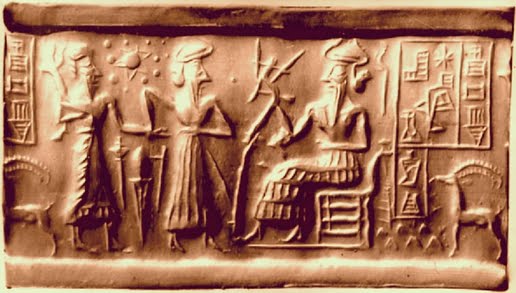 Enki. About 2,500 BCE. Note the image of planets revolving around the Sun!
Enki. About 2,500 BCE. Note the image of planets revolving around the Sun!
The sentient soul were the connection to the spiritual world, and wisdom, at that time. Here we also see the descent into the physical.
Here Enkidu gave tribute to Gilgamesh, representing the mind soul. The next tells about the sacred marriage between the sentient and mind soul, or the etheric and physical body:
The language of Gilgamesh, from his prophetic dreams (“I loved [Enkidu] and embraced [him] as a wife”) to the bridal bed in Uruk — Enkidu’s in retrospect — clearly refers to a “sacred marriage“: the spiritual union or blending of the inner and outer man. None of the extant material names a victor, but the Old Babylonian story given above suggests that the initial strife or “wrestling” is brought to an abrupt end by mutual recognition: Gilgamesh “bent his knees” (to Enkidu’s stature) and “planted his foot in the ground.” Both phrases are apparent wordplays on Enkidu’s name, indicating a successful (or “victorious”) bonding and assimilation. Enkidu’s subsequent acknowledgment and friendly embrace with Gilgamesh confirm their acceptance of the relationship.Up to this point the story has been prologue — an allegory about the evolution and creation both of mankind and of a truly human individual. From here on Gilgamesh and Enkidu go as one, faithful to each other until death. In the Sumerian stories, Enkidu remains the servant of Gilgamesh; in the Babylonian version, Gilgamesh’s mother adopts Enkidu — he becomes not only the servant, companion, and friend of Gilgamesh, but also his younger “brother.” Viewed as a single composite character, Gilgamesh-Enkidu represents the conjoining of heaven and earth, of spirit, soul(s), and body, in a full sevenfold partnership (5) necessary for one to succeed in the hero’s quest. [4]
The one tells that the sentient soul (Enkidu) is below (sevant of) the mind soul (Gilgamish), where he is a younger brother in the other tradition.
With Humbaba the terrible we are in Eden and he is known by Enkidu, which means they are related, and he guards the trees of wisdom and life. Enkidu, representing the Luciferic wisdom, is not ready to fight the Ahrimanic spirits, so he works against Gilgamesh.
This is part of the life of man, going through the twelve signs of the Zodiac:
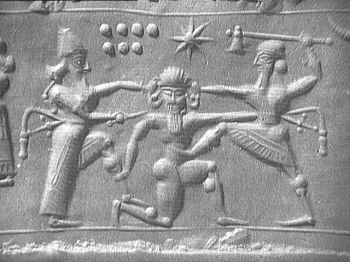 Gilgamesh and Enkidu with Humbaba
Gilgamesh and Enkidu with Humbaba
…
As Gilgamesh and Enkidu approached the forest, their trepidation grew. Shamash sent a message from the sky: “Humbaba has removed six of his seven cloaks. … They saw the height of the Great Cedar. Where Humbaba walked, a path was made. The road was good… [4]
The seven is connected to the chakras, and the seven-terrored was the chakras to clean. The path is the path of Karma.
On the six days travel (and seven nights?) Enkidu interprets the dreams of Gilgamesh, demonstrating that he is closer to the spiritual world. On the entrance to the Cedar Forrest:
Gilgamesh wins over Lucifer/Enkidu and they work together against Ahriman.
Here the Ahrimanic Humbaba tries to split the two, but Enkidu now inspires Gilgamesh with courage. When man has won his fight with Lucifer, he works as helper for man, as a holy spirit.
Here again Enkidu/Lucifer helps Gilgamesh against the Ahrimanic, which on it’s side bans the Luciferic from the physical plane. Enkidu dies, separates man from the spiritual, which introduces death, as man no longer remember his previous lives. The Sentient soul looses it’s sight into the spiritual world, the end of the old clairvoyance.
 Shamash (the Sun) between Mashu’s Twin Peaks,
Shamash (the Sun) between Mashu’s Twin Peaks,
Akkadian, 3rd millennium BC (British Museum)
He now starts his journey on the pure physical plane incarnating through the twelve star signs:
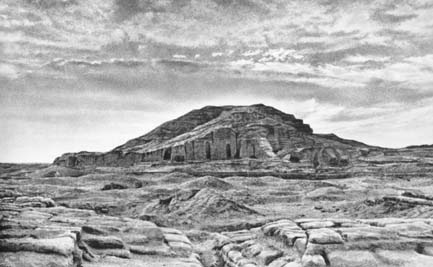 Ziggurat in the Eanna Sector at Uruk (Andre Parrot, Sumer)
Ziggurat in the Eanna Sector at Uruk (Andre Parrot, Sumer)
References
1. Rudolf Steiner: Occult History, Lecture 1;
2. Rudolf Steiner Occult History, Lecture 2;
3. Richard Hooker Mesopotamia Gilgamesh Summary, Washington State University;
4. W. T. S. Thackara The Epic of Gilgamesh: A Spiritual Biography
Full text of Gilgamesh Epic, Gilgameš, Enkidu and the nether world.
- The Temple Legend by Rudolf Steiner
- The Masonic Legend by Max Heindel
- The Hiramic Legend by Manly P. Hall
Use back-button to go back to text!
Map
 The Orphic Egg
The Orphic Egg



![kimgraaemunch [] GMail () com](https://kimgraaemunch.files.wordpress.com/2017/02/kimgraaemunch-g.png?w=210)












